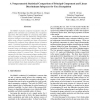Free Online Productivity Tools
i2Speak
i2Symbol
i2OCR
iTex2Img
iWeb2Print
iWeb2Shot
i2Type
iPdf2Split
iPdf2Merge
i2Bopomofo
i2Arabic
i2Style
i2Image
i2PDF
iLatex2Rtf
Sci2ools
CVPR
2001
IEEE
2001
IEEE
A Nonparametric Statistical Comparison of Principal Component and Linear Discriminant Subspaces for Face Recognition
The FERET evaluation compared recognition rates for different semi-automated and automated face recognition algorithms. We extend FERET by considering when differences in recognition rates are statistically distinguishable subject to changes in test imagery. Nearest Neighbor classifiers using principal component and linear discriminant subspaces are compared using different choices of distance metric. Probability distributions for algoriithm recognition rates and pairwise differences in recognition rates are determined using a permutation methodology. The principal component subspace with Mahalanobis distance is the best combination; using L2 is second best. Choice of distance measure for the linear discriminant subspace matters little, and performance is always worse than the principal components classifier using either Mahalanobis or L1 distance. We make the source code for the algorithms, scoring procedures and Monte Carlo study available in the hopes others will extend this compar...
Algoriithm Recognition Rates | Computer Vision | CVPR 2001 | Evaluation Compared Recognition | Face Recognition Algorithms | Linear Discriminant Subspace | Recognition Rates |
| Added | 12 Oct 2009 |
| Updated | 12 Oct 2009 |
| Type | Conference |
| Year | 2001 |
| Where | CVPR |
| Authors | J. Ross Beveridge, Kai She, Bruce A. Draper, Geof H. Givens |
Comments (0)

